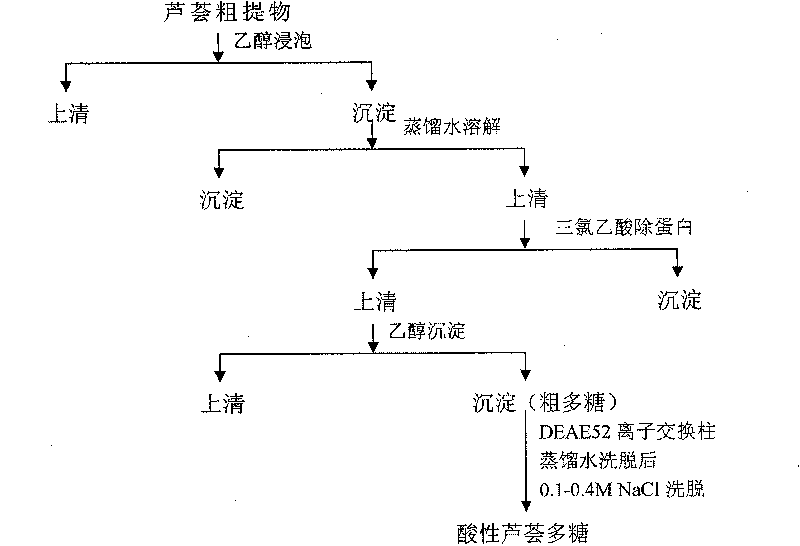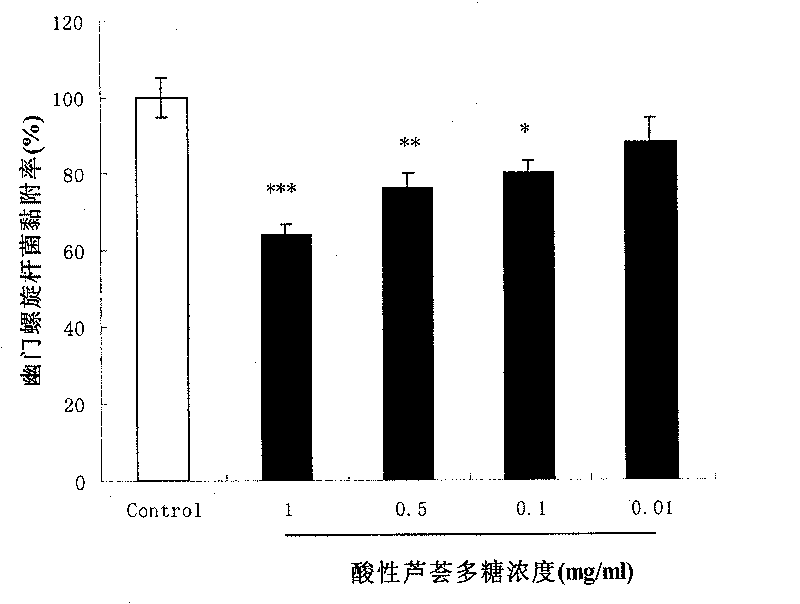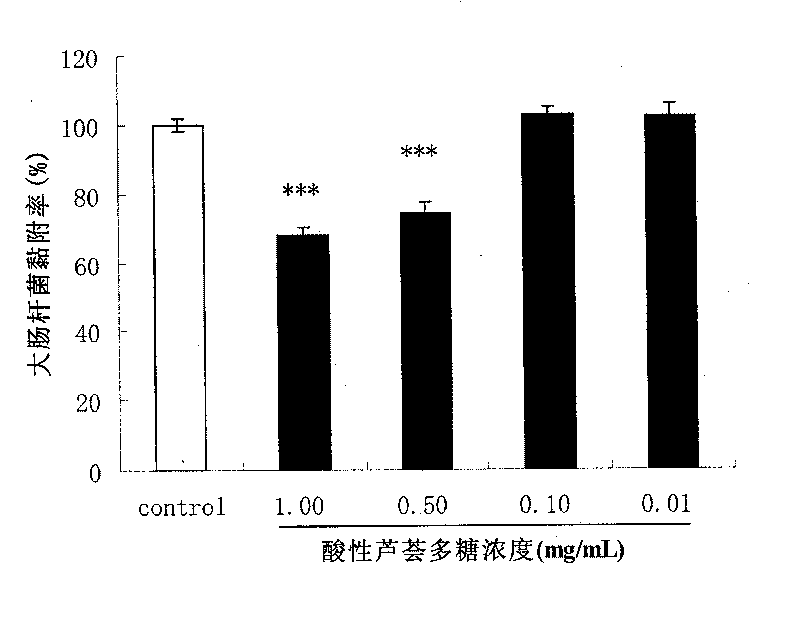Acidic aloe polysaccharide as well as preparation and purification method and application thereof
An aloe polysaccharide and acidic technology, which is applied in the direction of pharmaceutical formulas, organic active ingredients, and medical preparations containing active ingredients, etc., can solve the problems of increased incidence of drug-resistant strains, treatment failure, etc., achieve high yield and reduce adhesion rate , equipment requires simple effect
- Summary
- Abstract
- Description
- Claims
- Application Information
AI Technical Summary
Problems solved by technology
Method used
Image
Examples
Embodiment 1
[0025] Preparation and purification of embodiment 1 acidic aloe polysaccharide
[0026] (1) Fresh aloe leaves are chopped, extracted with hot water, and precipitated with ethanol to obtain a crude extract. Weigh an appropriate amount of crude extract, soak it twice with 50-70% ethanol for 24-48 hours each time, after the residue evaporates to dry the solvent, dissolve it in an appropriate amount of distilled water with stirring, and centrifuge to remove the insoluble matter. Trichloroacetic acid was added to the supernatant to remove protein, and after standing overnight, the supernatant was collected by centrifugation, and the above operations were repeated. After the supernatant was concentrated under reduced pressure, 95% ethanol was added to stand overnight and then centrifuged. After the precipitation was dried, a white or light yellow blocky solid was obtained, which was the aloe crude polysaccharide.
[0027] (2) Aloe crude polysaccharides were purified by ion exchange...
Embodiment 2
[0028] Example 2 Inhibitory effect of acidic aloe polysaccharides on Helicobacter pylori adhesion to MKN 45 cells
[0029] (1) Helicobacter pylori was streaked and inoculated on Columbia agar medium (containing 7% fresh sheep blood), and cultured at 37° C. for 3 days in a microaerophilic environment. Afterwards, the colonies were scraped and placed in sterilized physiological saline, and the bacterium-adjusting solution was at an appropriate concentration. Add FITC-DMSO solution to the prepared bacterial solution, and incubate at room temperature for 1-3 hours. Then centrifuge the marked bacterial suspension, pour out the supernatant, add D-Hanks solution containing Tween-20 and pipette several times, continue centrifuging, repeat the above operation twice, and wash off the unmarked FITC.
[0030] (2) Discard the original culture medium of MKN45 cells cultured in the 96-well plate, and replace with 2% calf serum and 1640 culture medium containing acidic aloe polysaccharides o...
Embodiment 3
[0032] Example 3 Effect of acidic aloe polysaccharides on Escherichia coli adhesion to LOVO cells
[0033] LOVO cells were cultured in 1640 medium containing 10% calf serum for 48 hours, and then cultured in 96-well plates. Escherichia coli was cultured in LB medium for 24 hours, and the colonies were scraped and labeled with FITC according to the above method. Discard the original culture medium of LOVO cells cultured in the 96-well plate for 24 hours, and add acidic aloe polysaccharides with the contents of 0, 0.01, 0.1, 0.5, 1.0mg / ml and 2% calf serum to each group of 12 wells 1640 medium, incubate for 1h. After adding FITC-labeled Escherichia coli and incubating for 1 h, the unadhered bacteria were washed away, and the fluorescence value was measured with a microplate reader. see results image 3 .
[0034] image 3 The results showed that, compared with the control group, the adhesion rate of Escherichia coli to LOVO cells decreased to 78% (p<0.001) and 68% (p<0.001) r...
PUM
| Property | Measurement | Unit |
|---|---|---|
| molecular weight | aaaaa | aaaaa |
Abstract
Description
Claims
Application Information
 Login to View More
Login to View More - R&D
- Intellectual Property
- Life Sciences
- Materials
- Tech Scout
- Unparalleled Data Quality
- Higher Quality Content
- 60% Fewer Hallucinations
Browse by: Latest US Patents, China's latest patents, Technical Efficacy Thesaurus, Application Domain, Technology Topic, Popular Technical Reports.
© 2025 PatSnap. All rights reserved.Legal|Privacy policy|Modern Slavery Act Transparency Statement|Sitemap|About US| Contact US: help@patsnap.com



